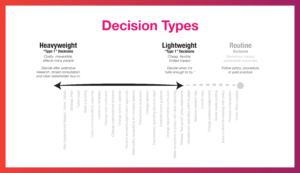Decision-making is the most important “system” in your organization. Design that system carefully.
In this multipart series of posts, we’ll cover the key elements of good decision-making, including decision types, roles, and methods. While these guidelines might be easy to interpret as “tips,” I’d suggest that these are critical patterns that should be ironed into the organization—and that in doing so, you will build long term organizational capacity and alignment.
First up? Decision Types.
Decision Types: A Spectrum… with Clear Polarity
Let’s take a moment to remember what “decide” really means. “Decision” literally means “to cut away.” (Think of the word “incision” for contrast.) Every time we use the word “decision,” we should remember we are talking about removing options, eliminating possibilities, and, in so doing, bringing FOCUS to our actions and to the allocation of resources. The most important concept in strategic thinking is “no.”
Etymology covered, let’s dig in: there are two major “types” of decisions—and these two types represent two ends of a spectrum:

“Heavyweight” Decisions are decisions that are high risk, high cost, irreversible, or have broad impact on organizational activities, programs, or culture. Such decisions may call for careful consideration, and slow, inclusive, process-driven decision-making defined by research, consultation, and discussion.
“Lightweight” Decisions are low-risk, low cost, reversible, localized decisions. These decisions can be made in a quicker and even experimental fashion. The reversibility and low cost of these decisions tends toward quicker and more unilateral decision-making, based on imperfect information. Most decisions in an organization are of this type.
Heavyweight decisions are facilitated by gathering as much information as possible. The primary risk to heavyweight decision-making comes from the fact that there is always more information to discover, and without setting careful boundaries, the pursuit of “all” information can result in decision paralysis. Suddenly you are facing the age old challenge of “the quest for perfect preventing the accomplishment of better.” (Avoiding this trap is important if you need to quicken your planning cycles.)
In contrast, Lightweight decisions should be encouraged based on merely “enough” information; action on lightweight decisions should proceed when decision-makers think it is “safe enough to try,” allowing the results themselves to fill in unknowns.
Decision Types Imply Approval and Consultation Patterns
It’s easy to see how this distinction between decision-types immediate implies for a different treatment of “heavy” decisions vs. “light” ones. Heavy decisions call for consultation and careful consideration, but light ones call for quick action. Heavy decisions might demand explicit approval from higher-ups, whereas light decisions get made with implicit approval all day long.
This simple distinction in decision types can help crystalize all sorts of positive patterns in the organization—and it can help identify those patterns which should be eschewed. Decision types are critical when considering planning approaches, organizational structures, and even day to day management patterns and discussions.
In our next post, we’ll discuss the four critical roles that comprise a powerful and efficient decision-making body.

NB: Jeff Bezos explains the principal of decision type quite well, but I cannot possibly imagine that he invented it. He also uses the arbitrary labels of “Type 1” and “Type 2” to describe Heavyweight and Lightweight decisions respectively, and I’ve found that confusing.
NB2: I describe “decision-making” as a critical “system” in your organization. If you want to develop a better sense of systems thinking, I can recommend some reading.